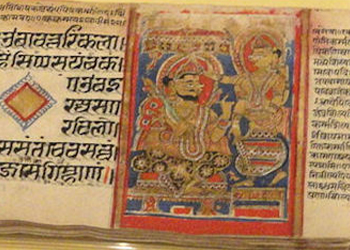 Historically, Ganadhars passed on the Āgam Sutras orally to their disciples who memorized and passed on to the next generations thereafter. This tradition of passing the knowledge from the memory in its total form lasted for about 160 years until Bhadrabāhu Swami. After Bhadrabāhu Swami, the mental ability of Ācāryas gradually declined and they could not memorize the entire Āgam-sutras. However, as per Shvetāmbar
Historically, Ganadhars passed on the Āgam Sutras orally to their disciples who memorized and passed on to the next generations thereafter. This tradition of passing the knowledge from the memory in its total form lasted for about 160 years until Bhadrabāhu Swami. After Bhadrabāhu Swami, the mental ability of Ācāryas gradually declined and they could not memorize the entire Āgam-sutras. However, as per Shvetāmbar
tradition, around 400 AD (800 years after Bhagawān Mahāvīra Nirvana) the memorized Āgam-sutras were written down. At that time no one remembered 14 Purvas and 12th Anga-Āgams. The remaining 11 Anga Āgams were partially remembered. As per Digambars tradition, the written Shvetāmbar Āgam-sutras contained many errors and they did not accept them as original teaching of Bhagawän Mahāvīra. Hence, they hold that all original Āgam- sutras are lost with time. For some time after Bhagawān Mahāvīra’s Nirvana, the Jain Shramans did not pen their Āgams in book form but preserved them by memorization. They considered that possessing books would constitute violation of the vow of nonattachment and non-possession. Then came the time, when they totally changed their attitude towards the possession of books because there was a fear of the destruction (due to loss of the art of memorization) of the Jain Āgams. Whatever wealth of the Āgam, which was still extant at that time, remained protected and preserved. Consistent with Shvetāmbar Murtipujak beliefs, there are three Āgam temples (Āgam Mandirs) which have 45 Āgams engraved either on walls or on copper plates. They are in Palitana, Surat and Shankheswar. There are several places (Jnān-mandirs) like Ahmedabad, Patan, Surat, Khambhat, Jesalmer, Pindvada, Mehsana, Ratalam, Ahor, Tharad, Guda, and Surendranagar where all the Āgams are available in their libraries.
Jainavenue is a medium to serve the spiritual path of Jainism
Jain scriptures are known as Jain Āgam literature. Jains do not have one text as a scripture, but they recognized many texts as their scripture. Different sects recognized different number of scriptures. The Āgam Sutras teach the eternal truth about conduct, equanimity, universal affection, friendship, the eternal truths on thinking, namely, the principle of relativity, and the principle of pluralisms (Anekāntavāda). The Āgam Sutras teach the eternal truth about conduct, equanimity, universal affection, friendship, the eternal truths on thinking, namely, the principle of relativity, and the principle of pluralisms (Anekāntavāda). It also teaches many spiritual things including great reverence for all forms of life, soul, Karma, universe, strict codes of asceticism, rules for householders, compassion, nonviolence, and non- possessiveness. After attaining Keval-Jnān at the age of 42, Bhagawān Mahavira delivered sermons to the common people in local language called Ardha-Māgadhi Prākrit for next 30 years. The essence of these sermons was compiled orally into many texts (known as Sutras) by His immediate disciples called Ganadhars. These Sutras are divided into 12 main texts known as 12 Ang Āgam Sutras or 12 Anga-pravishtha Āgams or Dvādashāngi (main canons). The 12th Ang Āgam Sutra (text) is known as Drashtivāda. It is believed that this Ang Āgam was compiled first but it was the most difficult to learn and hence monks learned this sutra at the end. This Āgam consist of 14 Purvas, life of all Tirthankars, description of other creeds that existed, how to acquire special power such as walking on the water or flying in the air. All Jain sects believe that this Agam got lost (no one remember it) in earlier time from 2nd century BC to 2nd century AD. In addition to the twelve Anga-pravishtha Sutras composed by the Ganadhars, other canonical literature (Anga-bāhya Āgams) composed on the basis of these 12 Angas, by Shruta-Kevali Acharyas (Sthavirs or elder monks) in an easier format for the understanding are also included as part of the Jain Āgams. The Jain Āgams consist of 12 Anga Pravishtha Āgams (includes 14 Purvas) and Anga-bāhya Āgams (34 for Shvetāmbar Murtipujak, 21 for Shvetāmbar Sthānakavāsi and Terāpanthi, and 14 for Digambar) of different traditions.
About Author
Courtesy: www.jainlexicon.com
Academic Advisor: Dr.Jitendra B.Shah, Ahmedabad
General Editor: Dilip V. Shah, Philadelphia


Thanks for sharing. I read many of your blog posts, cool, your blog is very good.